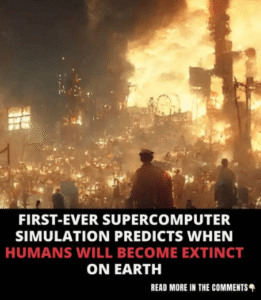A supercomputer simulation has sparked global intrigue and concern after it predicted a possible timeline for human extinction. Using complex algorithms, climate data, resource depletion models, and geopolitical risk assessments, the system projected a bleak future scenario in which humanity could face collapse by the year 2050 or later, depending on several critical variables. While the prediction is not a guarantee, it has renewed discussions among scientists, policymakers, and the public about how close civilization may be to a tipping point.
The simulation, part of a long-term study conducted by researchers using one of the world’s most advanced artificial intelligence models, analyzed thousands of possible future outcomes. It drew from environmental statistics, economic trends, sociopolitical instability, energy consumption, and ecological stress. According to the data, the combination of climate change, unsustainable resource use, and global conflict could reach a convergence point by mid-century, leading to widespread societal breakdown.
One of the central drivers in the simulation was climate change. The model accounted for rising global temperatures, increasing frequency of extreme weather events, sea level rise, and declining agricultural productivity. These factors could result in mass displacement, famine, and economic collapse, especially in vulnerable regions. If left unaddressed, the cascading effects could destabilize even wealthy nations.
The supercomputer also considered geopolitical tensions and the risk of nuclear conflict. It noted that as resources become scarcer—particularly freshwater, food, and energy—competition could intensify between nations. If diplomacy fails, the risk of large-scale war increases, with potentially catastrophic consequences for the global population.
Another major component of the model was the role of artificial intelligence and automation. While these technologies offer enormous potential, the simulation highlighted the risk of job displacement, increased inequality, and possible misuse of advanced AI systems. Without proper oversight and ethical safeguards, technological advancements could contribute to social unrest or even existential threats.
Ecological degradation factored heavily into the results. The rapid decline of biodiversity, deforestation, ocean acidification, and pollution were all listed as pressures that could cause ecosystems to collapse. Such damage would directly affect food supplies, fresh water sources, and climate regulation mechanisms, which are essential for human survival.
The timeline projected by the supercomputer was not exact but suggested a “critical window” from 2040 to 2050 during which major action is required. If humanity does not significantly change its trajectory by then, the model suggests that collapse could become unavoidable within the following decades. The extinction scenario includes not just a reduction in population but a complete breakdown of systems required for modern life—healthcare, governance, transportation, and food distribution.
Researchers involved in the simulation emphasize that the prediction is not meant to be a doomsday prophecy but a warning. It illustrates one of many potential outcomes and underscores the urgent need for cooperation, innovation, and reform. If meaningful changes are made in energy policy, consumption habits, international relations, and climate strategy, the worst-case scenarios can likely be avoided.
The study has sparked debate within the scientific community. Some experts argue that the model is too pessimistic and doesn’t fully account for human adaptability and resilience. Others defend it as a necessary wake-up call, especially in the face of political inaction and climate denial. While predictions of extinction are not new, the involvement of AI and supercomputing adds a modern and powerful layer of analysis.
Public reaction to the simulation has been mixed. Some view it as a motivation to engage more seriously with environmental and social issues. Others have expressed fear or skepticism, questioning the reliability of predicting complex human futures through data models alone. Nonetheless, the story has gained traction and added urgency to conversations about the future of the planet.
In the end, the supercomputer’s prediction serves not as a final verdict but as a stark reminder: the choices humanity makes today will shape tomorrow. Extinction is not a fixed outcome, but without decisive global cooperation and sustained action, the risk grows with each passing year.


